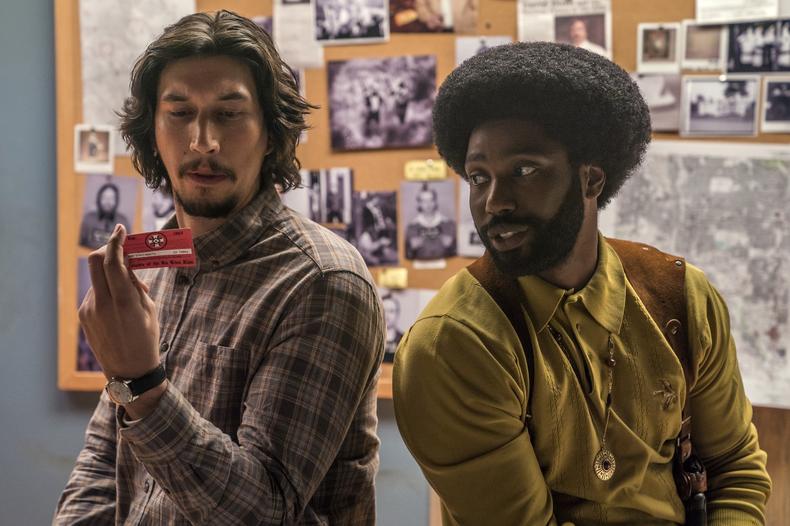
Becoming an actor is often an arduous process—but knowing what the different types of acting roles are and how they fit into a production helps. Types of TV and movie roles are different from an acting “type,” which is a combination of personal traits found on most character breakdowns. Whether bit parts or starring roles, acting covers a diverse range, offering ample opportunities for those hoping to break into the biz. Role types vary across locations and mediums, and mobility between types of acting roles can mean upward trajectory in one’s career.
 “BlacKkKlansman” Courtesy Focus Features
“BlacKkKlansman” Courtesy Focus Features
Movie roles and TV roles use similar types of actors, although the ongoing nature of TV series means more categorical nuance. The main acting role types in film and TV include:
Series Regular or lead actor
In a TV show, the series regular role is one of the main characters, appearing in nearly every episode. In a film, the lead is one of the main characters that the narrative centers around.
- Example: Frasier Crane (Kelsey Grammer) in “Frasier” is a series regular. Cady Heron (Lindsay Lohan) is the lead in “Mean Girls.”
Supporting actor
Supporting actors perform at a level below that of lead actors, but are still critical to a film’s storyline. They might be a close friend, family member, romantic partner, or even antagonist.
- Example: Adam Driver was a supporting actor in his role as Detective Flip Zimmerman in “BlacKkKlansman,” which featured John David Washington in the lead role as Detective Ron Stallworth.
Recurring role
A recurring role is a TV character who appears in multiple episodes—anywhere between two episodes and several seasons. The part is more intricately woven into the show plotline than a guest star role.
- Example: Jerry’s arch-nemesis Newman (Wayne Knight) is a recurring character on “Seinfeld,” appearing in 44 of the show’s total 173 episodes.
Day player
A day player, also called a co-star, is an actor hired on a short-term contract who is only on set for a day or two. Situated somewhere in the liminal space between background actors (who don’t have lines) and main characters (who have many lines and are in multiple episodes), day players only have a few lines. As casting director Ilene Starger writes of day player parts, “A line, a few lines, or sometimes just a word can—in the right hands—paint a vivid character and become a lasting aspect of a project.”
- Example: A day player might be cast as a bartender, dog walker, or gallery owner who only appears in one episode and speaks—but not to the principal actors.
Bit part
A bit part is a role with direct interaction with principal actors and up to five lines of dialogue, known as the under-five in the U.S. Bit part actors are sometimes listed in the credits due to their brief yet poignant appearances in the production. If you make a good enough impression, like Christian James Pinter did, you might even get a bigger part written just for you.
- Example: The postal worker (Jack Albertson) in “Miracle on 34th Street” constitutes a bit part role.
Guest star
Guest stars usually have multiple scenes and lines, and sometimes even a story arc. A guest star might also be a celebrity cameo.
- Example: Christina Applegate guest stars in two episodes of “Friends” as Amy Green, Rachel’s sister, who takes her niece to get her ears pierced without obtaining the go-ahead from her parents.
Background actor
Background actors, sometimes called extras or atmosphere actors, are usually seen in the background of a scene to provide a sense of realism and ambiance. They do not have any lines.
- Example: People in the background in a street shot or students in the background in a school scene.
Body double
A body double stands in for a primary actor’s shots. To appear as the same character, the body double’s face is covered, and they wear clothing, accessories, or wigs to appear as the actor they’re meant to represent.
- Example: Isla Fisher used a body double for her nude scenes as Gloria Cleary in “Wedding Crashers.”
Stunt double
A stunt double is a specific type of double who performs stunts in dangerous and complicated scenes. They are specially trained performers who fill in for regular actors to keep them from injury.
- Example: Stunt double Tanoai Reed fills in for many of Dwayne “The Rock” Johnson’s stunts, including in “The Scorpion King” and the “Fast & Furious” franchise.
 “The Music Man” Credit: Julia Cervantes
“The Music Man” Credit: Julia Cervantes
Principal cast
The main cast or starring roles are usually the actors who have the final bow. They convey the primary storyline in a theatrical production. When there isn’t a primary protagonist, the main roles comprise an ensemble cast. When there is a protagonist, they’re called a leading actor.
- Example: In her role as Elphaba, Idina Menzel is one of the lead actors in “Wicked,” opposite Kristin Chenoweth as Glinda.
Understudy
The understudy learns all the lines and movements that the primary actor in a play is performing. If the primary actor cannot perform, the understudy takes over their part, performing in their stead. Understudies usually also perform in a smaller role in the production.
- Example: Anthony Hopkins was the understudy for Sir Laurence Olivier in National Theater’s “The Dance of Death” when the primary actor had appendicitis. Hopkins was given a standing ovation at curtain call.
Swing
Similar to an understudy, swings prepare for multiple different roles in the show and are ready to step into any of them at any time. Unlike understudies, however, a swing is an offstage role and does not participate in the ensemble on a regular night.
- Example: The latest Broadway revival of “The Music Man” saw swing Kathy Voytko step in for Sutton Foster to play the lead of Marian Paroo alongside Hugh Jackman.
Chorus/ensemble
The chorus provides background and supporting performances for a play, singing or otherwise. Chorus members provide exposition and give insight into characters’ emotional states through song, dance, and narration.
- Example: The Broadway production of “The Devil Wears Prada” includes a chorus of designers who call out Andy’s unfashionable clothing choices.
In broad strokes, these acting roles can be categorized into lead, supporting, and background parts. Each role type has its own pay range and way of crediting actors—and each offers unique opportunities to carve out a career in entertainment.















